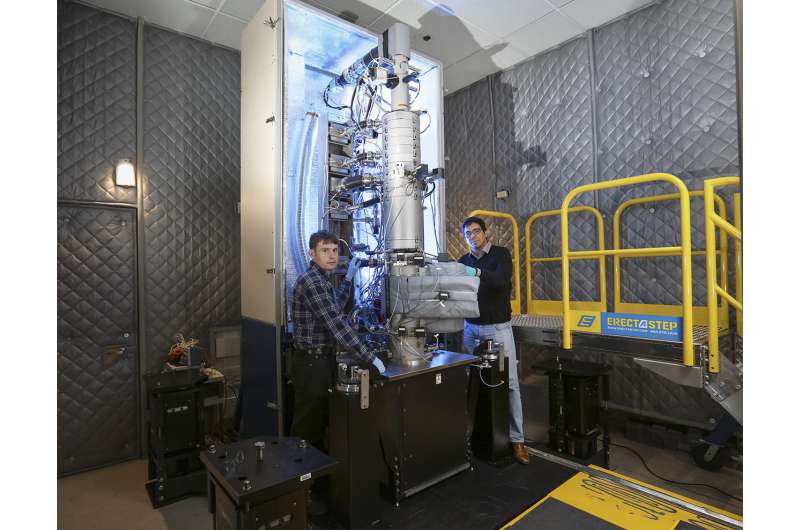Researchers develop spectroscopic thermometer for nanomaterials

A scientific team led by the Department of Energy's Oak Ridge National Laboratory has found a new way to take the local temperature of a material from an area about a billionth of a meter wide, or approximately 100,000 times thinner than a human hair.
This discovery, published in Physical Review Letters, promises to improve the understanding of useful yet unusual physical and chemical behaviors that arise in materials and structures at the nanoscale. The ability to take nanoscale temperatures could help advance microelectronic devices, semiconducting materials and other technologies, whose development depends on mapping the atomic-scale vibrations due to heat.
The study used a technique called electron energy gain spectroscopy in a newly purchased, specialized instrument that produces images with both high spatial resolution and great spectral detail. The 13-foot-tall instrument, made by Nion Co., is named HERMES, short for High Energy Resolution Monochromated Electron energy-loss spectroscopy-Scanning transmission electron microscope.
Atoms are always shaking. The higher the temperature, the more the atoms shake. Here, the scientists used the new HERMES instrument to measure the temperature of semiconducting hexagonal boron nitride by directly observing the atomic vibrations that correspond to heat in the material. The team included partners from Nion (developer of HERMES) and Protochips (developer of a heating chip used for the experiment).
"What is most important about this 'thermometer' that we have developed is that temperature calibration is not needed," said physicist Juan Carlos Idrobo of the Center for Nanophase Materials Sciences, a DOE Office of Science User Facility at ORNL.
Other thermometers require prior calibration. To make temperature graduation marks on a mercury thermometer, for example, the manufacturer needs to know how much mercury expands as the temperature rises.
"ORNL's HERMES instead gives a direct measurement of temperature at the nanoscale," said Andrew Lupini of ORNL's Materials Science and Technology Division. The experimenter needs only to know the energy and intensity of an atomic vibration in a material—both of which are measured during the experiment.
These two features are depicted as peaks, which are used to calculate a ratio between energy gain and energy loss. "From this we get a temperature," Lupini explained. "We don't need to know anything about the material beforehand to measure temperature."
In 1966, also in Physical Review Letters, H. Boersch, J. Geiger and W. Stickel published a demonstration of electron energy gain spectroscopy, at a larger length scale, and pointed out that the measurement should depend upon the temperature of the sample. Based on that suggestion, the ORNL team hypothesized that it should be possible to measure a nanomaterial's temperature using an electron microscope with an electron beam that is "monochromated" or filtered to select energies within a narrow range.
To perform electron energy gain and loss spectroscopy experiments, scientists place a sample material in the electron microscope. The microscope's electron beam goes through the sample, with the majority of electrons barely interacting with the sample. In electron energy loss spectroscopy, the beam loses energy as it passes through the sample, whereas in energy gain spectroscopy, the electrons gain energy from interacting with the sample.
"The new HERMES lets us look at very tiny energy losses and even very small amounts of energy gain by the sample, which are even harder to observe because they are less likely to happen," Idrobo said. "The key to our experiment is that statistical physical principles tell us that it is more likely to observe energy gain when the sample is heated. That is precisely what allowed us to measure the temperature of the boron nitride. The monochromated electron microscope enables this from nanoscale volumes. The ability to probe such exquisite physical phenomena at these tiny scales is why ORNL purchased the HERMES."
ORNL scientists are constantly pushing the capabilities of electron microscopes to allow new ways of conducting forefront research. When Nion electron microscope developer Ondrej Krivanek asked Idrobo and Lupini, "Wouldn't it be fun to try electron energy gain spectroscopy?" they jumped at the chance to be the first to explore this capability of their HERMES instrument.
Nanoscale resolution makes it possible to characterize the local temperature during phase transitions in materials—an impossibility with techniques that do not have the spatial resolution of HERMES spectroscopy. For example, an infrared camera is limited by the wavelength of infrared light to much larger objects.
Whereas in this experiment the scientists tested nanoscale environments at room temperature to about 1300 degrees Celsius (2372 degrees Fahrenheit), the HERMES could be useful for studying devices working across a wide range of temperatures, for example, electronics that operate under ambient conditions to vehicle catalysts that perform over 300 C/600 F.
More information: Juan Carlos Idrobo et al, Temperature Measurement by a Nanoscale Electron Probe Using Energy Gain and Loss Spectroscopy, Physical Review Letters (2018). DOI: 10.1103/PhysRevLett.120.095901
Journal information: Physical Review Letters
Provided by Oak Ridge National Laboratory



















